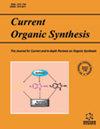Study of Heavy Metal Removal with Porous Nanocomposite Scaffolds based on Hybrid Inorganic/Organic Nanoparticles (MSN@COF)
IF 1.7
4区 化学
Q3 CHEMISTRY, ORGANIC
引用次数: 0
Abstract
aims: Synthesis of organic-inorganic hybrids as 3D adsorbents for heavy metal removal background: Synthesis of organic-inorganic hybrids objective: Study of heavy metal removal with porous nanocomposite scaffolds based on hybrid organic/inorganic nanoparticles (MSN@COF) method: Using soluthermal methods for the synthesis of organic-inorganic hybrids and studying the removal of heavy metals in them result: Precise and defect-free synthesis of organic-inorganic hybrids Removal of over 90% of heavy metals conclusion: In this research work, in order to achieve the desired product, mesoporous silica nanoparticles were first synthesized based on TEOS, and then the surface modification of these nanoparticles was done with APTES in order to achieve MSN-NH2. Next, organic covalent frameworks based on cyanuric chloride were synthesized. The main goal in this research work was the synthesis of porous nanocomposites based on MSN and COF, so that it is possible to synthesize hybrid organic/inorganic porous nanocomposites by in situ growth of COF on porous silica nanoparticles. Therefore, after synthesizing both hybrid organic/inorganic porous nanocomposites (COF and MSN) and examining their morphology and how to identify them, porous nanocomposites (MSN@COF) resulting from the growth of COF on MSN were synthesized. To achieve a proper comparison of the porosity and nature of these nanocomposites, once this nanocomposite was synthesized using MSNs whose surfactant was not removed, the CTAB surfactant was removed after COF growth on it. In another synthesis, the nanocomposite was synthesized from the growth of COF on MSN-NH2 whose surfactant was removed. This nanocomposite, due to the open pores of the MSNs, the growth of COF started by connecting to the amino groups obtained from APTES from within the MSN-NH2 themselves. The nanocomposite had less porosity than the other composite due to the growth of COF inside it. But the remarkable thing was the growth and presence of COF with its constituent atoms inside the MSN cavities. Due to the fact that porous nanomaterials have their own unique morphology, nature, function, and application according to their constituents and porosity category, both porous nanoparticles used in the preparation of these nanocomposites are well-known and widely used porous nanomaterials. They are in industry and medicine, so we decided to synthesize porous nanocomposites that have the special characteristics, behavior, and ability of both MSN and COF. Relevant analyses confirmed the synthesis of these porous nano absorbents. The growth of COF on MSNs, according to the data obtained from BET, has reduced the surface area and volume of pores in porous nanocomposites, but on the other hand, the presence of COF with its constituent atoms definitely gives a special characteristic and ability to nanocomposites. Porous materials will give in exchange for a decrease in the surface area and volume of the initial MSN cavities. The results of this study demonstrated that MSN@COF(WC) absorbs a higher percentage of zinc and cadmium metal ions than other adsorbents at various levels of adsorbent consumption, demonstrating that hybrid adsorbents are more effective than COF and MSN in removing these heavy metals from the primary solution. Also, the evaluation of the equilibrium time showed that the adsorption of heavy metals zinc and cadmium by MSN, COF adsorbents has a greater speed, while the MSN@COF(NC) hybrid adsorbent needs the greatest time to reach equilibrium conditions. When hybrid absorbents and two other absorbents were compared at various pollution levels, it became clear that hybrid absorbents at low pollution levels and other absorbents at high pollution levels are more effective in removing metals heavier than the original solution. In conclusion, the results of this study showed that the hybrid adsorbents have a larger absorption amount and the other two adsorbents have a higher absorption speed to reach equilibrium conditions in the process of removing zinc and cadmium metals from the stock solution. other: All the necessary information is available inside the text.利用基于无机/有机混合纳米颗粒的多孔纳米复合支架(MSN@COF)去除重金属的研究
目的合成有机-无机杂化物作为去除重金属的三维吸附剂的背景:合成有机-无机杂化物的目的:研究基于有机/无机混合纳米粒子(MSN@COF)的多孔纳米复合支架去除重金属的方法:使用溶热法合成有机-无机杂化物,并研究其去除重金属的效果:精确、无缺陷地合成有机-无机杂化物 去除 90%以上的重金属 结论:在这项研究工作中,为了获得所需的产品,首先以 TEOS 为基础合成了介孔二氧化硅纳米粒子,然后用 APTES 对这些纳米粒子进行了表面修饰,以获得 MSN-NH2。接着,合成了基于三聚氯氰的有机共价框架。这项研究工作的主要目标是合成基于 MSN 和 COF 的多孔纳米复合材料,以便通过 COF 在多孔二氧化硅纳米粒子上的原位生长,合成有机/无机混合多孔纳米复合材料。因此,在合成了两种有机/无机杂化多孔纳米复合材料(COF 和 MSN)并研究了它们的形态和鉴别方法之后,又合成了 COF 在 MSN 上生长所产生的多孔纳米复合材料(MSN@COF)。为了正确比较这些纳米复合材料的孔隙率和性质,在使用未去除表面活性剂的 MSN 合成这种纳米复合材料后,在其上生长 COF 后去除 CTAB 表面活性剂。在另一种合成方法中,COF 在去除了表面活性剂的 MSN-NH2 上生长后合成了纳米复合材料。这种纳米复合材料由于 MSN 具有开放的孔隙,COF 的生长是从 MSN-NH2 本身内部开始的,通过与 APTES 获得的氨基相连。由于 COF 在纳米复合材料内部生长,其孔隙率低于其他复合材料。但引人注目的是 COF 及其组成原子在 MSN 空腔内的生长和存在。由于多孔纳米材料根据其成分和孔隙率类别有其独特的形态、性质、功能和应用,制备这些纳米复合材料时使用的两种多孔纳米粒子都是众所周知且应用广泛的多孔纳米材料。因此,我们决定合成同时具有 MSN 和 COF 特性、行为和能力的多孔纳米复合材料。相关分析证实了这些多孔纳米吸附剂的合成。根据 BET 数据,COF 在 MSN 上的生长减少了多孔纳米复合材料的表面积和孔体积,但另一方面,COF 及其组成原子的存在无疑赋予了纳米复合材料一种特殊的特性和能力。多孔材料可以换取初始 MSN 空穴表面积和体积的减少。研究结果表明,在不同的吸附剂用量下,MSN@COF(WC) 吸收锌和镉金属离子的比例高于其他吸附剂,这表明混合吸附剂比 COF 和 MSN 更能有效地去除原溶液中的这些重金属。同时,平衡时间的评估表明,MSN、COF 吸附剂对重金属锌和镉的吸附速度较快,而 MSN@COF(NC) 混合吸附剂达到平衡条件所需的时间最长。将混合吸附剂和其他两种吸附剂在不同污染水平下进行比较,结果表明,低污染水平下的混合吸附剂和高污染水平下的其他吸附剂能更有效地去除比原液重的金属。总之,本研究结果表明,在从原液中去除锌和镉金属的过程中,混合吸附剂的吸附量更大,而其他两种吸附剂的吸附速度更快,能达到平衡条件:文中提供了所有必要信息。
本文章由计算机程序翻译,如有差异,请以英文原文为准。
求助全文
约1分钟内获得全文
求助全文
来源期刊

Current organic synthesis
化学-有机化学
CiteScore
3.40
自引率
5.60%
发文量
86
审稿时长
6-12 weeks
期刊介绍:
Current Organic Synthesis publishes in-depth reviews, original research articles and letter/short communications on all areas of synthetic organic chemistry i.e. asymmetric synthesis, organometallic chemistry, novel synthetic approaches to complex organic molecules, carbohydrates, polymers, protein chemistry, DNA chemistry, supramolecular chemistry, molecular recognition and new synthetic methods in organic chemistry. The frontier reviews provide the current state of knowledge in these fields and are written by experts who are internationally known for their eminent research contributions. The journal is essential reading to all synthetic organic chemists. Current Organic Synthesis should prove to be of great interest to synthetic chemists in academia and industry who wish to keep abreast with recent developments in key fields of organic synthesis.
 求助内容:
求助内容: 应助结果提醒方式:
应助结果提醒方式:


